The BlackBerry PlayBook Review
by Anand Lal Shimpi on April 13, 2011 9:00 PM EST- Posted in
- Tablets
- Smartphones
- RIM
- BlackBerry
- PlayBook
- Mobile
I suppose it's fitting that I should be the one to write our PlayBook review. Before Android and the iPhone, there were two mobile platforms/devices that I was hugely fond of: the Palm V and my BlackBerry. In fact, it wasn't until the iPhone that I finally let go of my last BlackBerry - moving on from the email era into the smartphone age.
Today's BlackBerry is of course very different than the devices I used in college. And the PlayBook is unlike anything RIM has ever done.
I don't believe any tablet maker has perfected the formula just yet. I made that abundantly clear in our review of the iPad 2. While you can't argue that Apple is the forerunner in the smartphone based tablet space, over the long term I still believe this is anyone's game. Remember, the leaders in the early days of the PC industry weren't the ones who ultimately dominated the mature market.
What follows is our review of RIM's first attempt at building a tablet. The PlayBook is far from perfect, but there's a foundation here that can be built upon if RIM has a good roadmap and good execution. And if you're a BlackBerry user, there's a lot of synergy to exploit.
| BlackBerry PlayBook Pricing Comparison | |||||
| 16GB | 32GB | 64GB | |||
| WiFi | $499 | $599 | $699 | ||
Let's get to it.
The Hardware
If we view the primary difference between the first and second generation of smartphone based tablets as being ergonomics and performance, the PlayBook falls squarely in between the two.
At 10mm thick the PlayBook (7-inch display) is more iPad 1 (9.7-inch) or Xoom (10.1-inch) than iPad 2 or Galaxy Tab 8.9, but what RIM lacks in thinness it makes up for in overall size. The PlayBook is an almost-pocketable tablet. Bigger than the 5-inch Streak and even bigger than the 7-inch Galaxy Tab, the PlayBook isn't a pain to port around. The PlayBook is small enough to snugly fit inside the outer pocket of a long men's winter coat or a lady's purse. While I definitely don't carry my iPad everywhere, if it were more functional I could see carrying the PlayBook with me more often than any other tablet.
The PlayBook's styling is modest, even for BlackBerry standards. The front has a single BlackBerry logo along the bottom bezel and a visible camera lens but that's it. Around back you've got RIM's logo, a larger lens for the rear-facing 5MP camera sensor and a sea of black.
The only buttons on the device are along the top of the PlayBook: power, volume down, pause/play and volume up. The power button is flush with the surface of the PlayBook's edge. You basically need a pointy finger nail (which I typically don't have) to press it easily and as a result the power button was pretty much useless to me. If you can manage to hit it the power button will lock the PlayBook, otherwise you'll have to leave the tablet idle until it automatically goes into standby. RIM tells me that final versions of the PlayBook will have this power button raised by 0.8mm, enough to make it easily clickable.
Press and hold the power button and you'll be greeted with a PC-like choice to either power off the PlayBook or restart it. I'm not sure how frequently RIM expects you to do the latter, but when testing it's a nice feature to have.
The volume up/down buttons work as expected, although the volume level itself doesn't seem to be very linear. There's a single 1/8" headphone jack up top, near a port for the PlayBook's microphone.
The PlayBook features a pair of pretty loud stereo speakers on the front of the device. Being used to the iPad's single speaker, the PlayBook's two speakers are nice.
Charging is always an issue on these USB devices. You can take Apple's approach and charge over USB, which unfortunately can take a while to fill up a tablet's battery. You also run into issues with older computers that don't support the USB Charging spec, resulting in charging-only-while-sleeping like the iPad. Then there's Motorola's approach with the Xoom where you don't charge over USB but have a dedicated port for an AC adapter. Charging times are significantly reduced but now you need to carry around an extra adapter with you wherever you go. RIM arrived at what's quite possibly the best solution. The PlayBook will charge over USB and it also features a higher amperage quick-charge port for use with some of its accessories.
The battery is of course not removable and there's no USB port or SD card reader.
The Form Factor
The PlayBook is only slightly larger than Samsung's 7-inch Galaxy Tab and maintains the same 7-inch screen size (albeit with a functional border around the screen). Given my complaints about current tablets not being incredibly portable compared to a smartphone, you'd think that I'd love the PlayBook's form factor. To be honest, for portability, I do.
| Tablet Specification Comparison | |||||
| Apple iPad 2 | BlackBerry PlayBook | Motorola Xoom | |||
| Dimensions | 241.2mm x 185.7mm x 8.8mm | 194mm x 130mm x 10mm | 249.1mm x 167.8mm x 12.9mm | ||
| Display | 9.7-inch 1024 x 768 | 7-inch 1024 x 600 | 10.1-inch 1280 x 800 | ||
| Weight | 601g (WiFi only) | 425g | 730g | ||
| Processor | 1GHz Apple A5 (2 x Cortex A9) | 1GHz TI OMAP 4430 (2 x Cortex A9) | 1GHz NVIDIA Tegra 2 (2 x Cortex A9) | ||
| Memory | 512MB | 1GB | 1GB | ||
| Storage | 16GB up to 64GB | 16GB up to 64GB | 32GB + microSD card | ||
| Pricing | $499 up to $829 | $499 up to $699 | $599 - $799 | ||
While I'm almost never tempted to bring the iPad with me when I'm going around town, the PlayBook is a far easier sell. It's almost pocketable (and actually pocketable if I'm wearing a big jacket) and isn't too heavy.
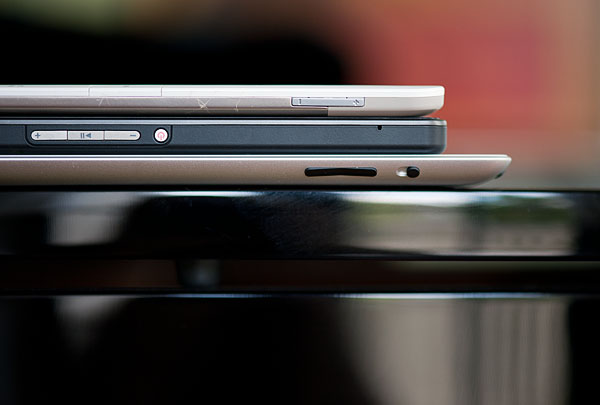
From top to bottom: Amazon Kindle 2, BlackBerry PlayBook, Apple iPad 2
Even when I'm not out and about, the PlayBook is quite usable as a content consumption device. In portrait mode fonts are a bit too small for me to read comfortably on the couch but in landscape it works well as a reddit browsing machine.
It's in the couch-lounging usage model that the PlayBook does fall short of the iPad or Xoom. But in terms of portability the PlayBook is clearly a much better balance of functionality and mobility. If you read between the lines you'll come to the same conclusion I have: neither the PlayBook nor the iPad is the perfect form factor for a tablet. Further more, I'm not sure there is a single perfect tablet form factor.
Apple tends to be a one-size-fits-all company when it comes to iOS. You want a smartphone? That'll be a 3.5-inch screen on an iPhone. Want a tablet? 9.7-inch iPad. It's interesting given how carefully Apple selected its four notebook sizes: 11, 13, 15 and 17-inches.
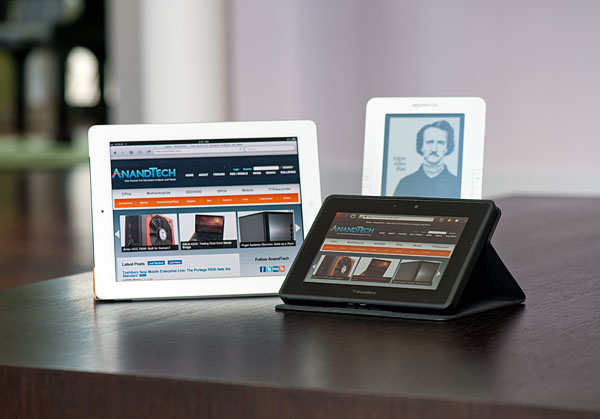
Clockwise: Apple iPad 2, Amazon Kindle 2, BlackBerry PlayBook in Convertible Case
Ultimately I don't think tablets will fall into the one-size-fits-all category. Instead I believe they're ultimately headed for some sort of a convergence with netbooks or notebooks. Today that's difficult to see because they lack a common hardware ISA, OS and even apps, but you don't have to look too far into the future to see those problems going away.
While I appreciate the PlayBook's portability and would definitely carry it around more than an iPad, it's not as nice to use laying back on a couch. The screen is too small to comfortably read in portrait mode and even in landscape things can get a bit cramped.
RIM's market research shows a clear preference for portability, hence the PlayBook's introductory 7-inch form factor. However RIM also pointed out that the BlackBerry comes in all shapes and sizes, indicating that the PlayBook would ultimately be available in different form factors as well. RIM also indicated that the 7-inch PlayBook may not be the smallest size offered either. Clearly RIM views the tablet market much like the notebook market: there will be ultraportables and there will be workhorses, with tons of choice in between. The 7-inch PlayBook is merely a starting point. Assuming RIM can fund the projects, we'll likely see both larger and smaller siblings in the future.



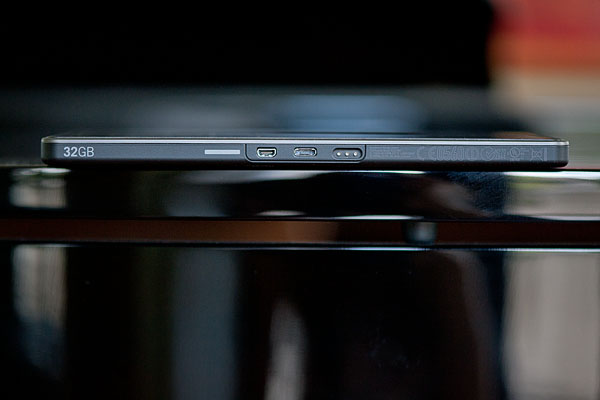
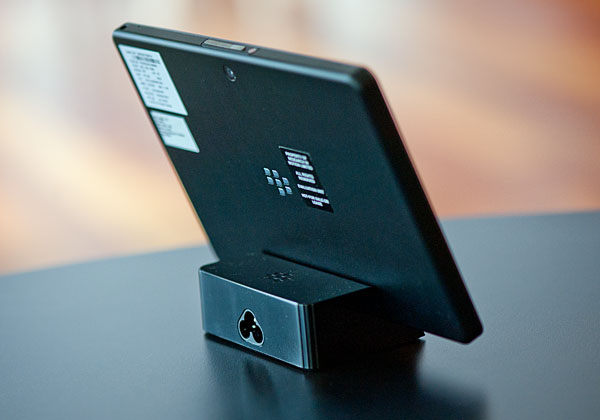
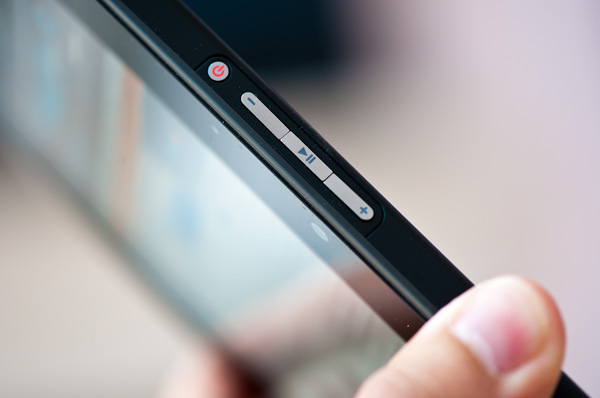
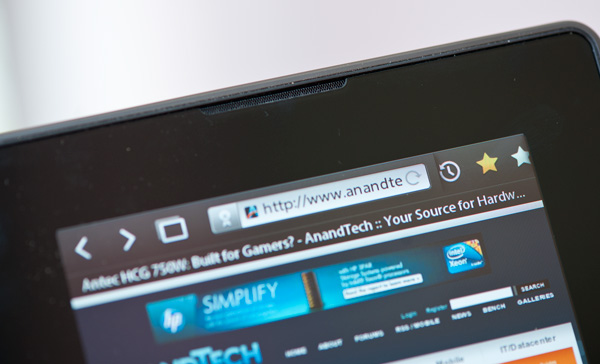








77 Comments
View All Comments
Azethoth - Thursday, April 14, 2011 - link
That is a curious statement. What do you want lots of memory for?I can see memory being better for a phone that you listen to music from as more memory = more of your (compressed) library can fit on it. Personally I only sync particular playlists to my phone / iPad anyway.
As for other stuff, well apps just do not consume a large amount of space. For my iPad 2 I went with the smallest memory size. The larger size I have on my original, er I mean on my sister's "new" iPad, was just a waste for me.
Chloiber - Thursday, April 14, 2011 - link
Because it's an easy way to share things and upgrade your memory if you need more. I won't pay 100$ for 16GB of NAND flash (which cost's like 15$).jjj - Thursday, April 14, 2011 - link
For a device that can shoot and play 1080p video 16GB-64GB of storage is very little (and anything above 16GB is way too costly) Then there are also photos,music,apps that maybe soon will be actually able to do things and become bigger,it is after all a computing device and even if smartphones/tablets are in their infancy we can still hope that they mature sooner rather than later.BuffyzDead - Thursday, April 14, 2011 - link
"The screen is too small to comfortably read in portrait mode and even in landscape things can get a bit cramped." Steve Jobs already warned the entire industry on this point. It's too small to be a successful tablet. Everyone has portability in their Smartphone."Apple's A5 still has a much faster GPU" .and the playbook isn't even shipping yet
"App launches are unfortunately a bit high latency. .....whole process takes a couple of seconds but it feels longer than firing up similar iOS or Honeycomb apps." just throw more CPU at the problem. You know, down the road.
"With no email or calendar apps, the PlayBook doesn't have a whole lot to notify you of. Presently the only notifications the PlayBook will deliver have to do with remaining battery capacity." LOL at this one.
I predict Now, this thing will never sell in volume. Even improved versions down the road won't sell.
3 reasons:
1) It's too small.
2) The User Experience does not even come close to that of the iPad1
3) NO APPS
Yes, while there are company's that may force this down their employees throat, that is not where the growth of tablet use is coming from, in enterprise.
It's coming 100% from employees wanting to use their iPad's in the work environment.
You finish with:
"there are still more revolutions that will take place between now and when the mobile market finally matures"
Ask yourself, Honestly, is there ANYTHING about this "experiment for RIM"
that has an inkling of REVOLUTION ????
Azethoth - Thursday, April 14, 2011 - link
The proper quote is:"While Apple and Google are clearly out to a substantial lead, there are still more revolutions that will take place between now and when the mobile market finally matures. I'm not saying that Apple or Google won't end up on top, I'm just saying that it's not guaranteed they will either."
and
"The PlayBook is a reasonable experiment for RIM, but I need to see more to really recommend the tablet."
See how in context Anand makes sense? Rather than claiming the ridiculous: "this RIM tablet is a revolution", Anand is merely saying that this is an immature industry. Everyone fully expects actual game changing revolutions in this area in the future.
Search this site for Anand's excellent follow up to the iPad 2 release that asks: "How do I as a blogger use a tablet to create [text] content". There were some responses about maybe covers that double as keyboards. There was wishful thinking about voice input maturing real soon now. Mostly there is a need for some kind of interface revolution before a tablet can become a reasonable answer for a blogger on the go. These are the revolutions Anand needs in a tablet.
BuffyzDead - Thursday, April 14, 2011 - link
Correct !I wholeheartedly agree with Anand's review and conclusion:
There are no guarantee's what the future may hold and he can not recommend this Playbook.
1) I wanted to add that this Playbook will in fact be a total failure. Time will prove me right or wrong. Again, I predict Total Failure.
2) I wanted to point out how RIM, as is evident by this Playbook version 1,
has demonstrated Zero in it's capability to provide ANY REVOLUTION.
At most, it's an outright attempt to copy or emulate (poorly) what the iPad REVOLUTION IS.
BTW,
If you think that "designing a tablet" to cater to "the blogger on the go" is a measure of success, then I pray for RIM's sake, you are not on their design team.
Anand has repeatedly pointed out how a tablet might just not be for him, in general.
I have maintained for the past 15 months that the iPad's true REVOLUTION, is that it CREATED a NEW MARKET.
ALL of Apples competitors are playing catchup & copycat to cater to that NEW MARKET, which the iPad CREATED.
SandmanWN - Thursday, April 14, 2011 - link
For real... lay off the coffee and Jobs shlong.melgross - Thursday, April 14, 2011 - link
For real, it's the only tablet so far that sold more than a small number. As many others have pointed out, so far the tablet market is really the iPad market. Other manufacturers have to prove that they can sell a large number of devices. We know that the Tab, is not a real tablet by Google's standards, and that it sold in much smaller numbers than the number shipped to retailers and cell companies. The Xoom is assumed to have managed about 100,000 sales, and what else has there been that seriously competes?Now, the Playbook, which has been criticized by those in the industry for having poor battery life, and problems with the software before release, despite RIM,s denials, is proving, from all the reviews I've now read today, to be having all of those problems just days before release. Pogue has stated that RIM is feverishly sending out updated on a daily basis. That's not good.
Other tablets won't arrive for at least a couple more months.
So what does the market really consist of now?
melgross - Thursday, April 14, 2011 - link
It's hard to say. There are a lot of writers who have said that they type just fine on the iPad's virtual keyboard. Everyone's different. I remember a lot of people complaining about the first iPhone's keyboard, but since then, many, if not most new smartphones have no physical keyboards anymore, so people are getting used to them.I'm typing on my iPad2 now. The only complaints about the way Apple set it up are that I think that too much space is wasted on the two large numeric keyboard call up keys at the bottom of the keyboard, much of which could have been used for other functions, such as an "@" key, for instance. Otherwise, it's fine. On a 7" screen, typing for longer periods will be more problematical.
yelped - Thursday, April 14, 2011 - link
Stop trolling, and PLEASE grow up.Thanks.